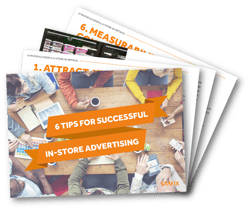
It is a studied fact that in-store advertising has a strong impact especially on purchases made by an impulse in the store. On the other hand, in-store advertising can be relatively expensive because of material, logistics and installation costs. That is why it is important to concentrate on the selection of the campaign material and plan carefully in order to find the most cost-effective and efficient solution.
We asked Esa Hyvärinen from Suomen Logistigo Oy about his thoughts on how in-store advertising is usually implemented and how it could be made more effective. Suomen Logistigo Oy is focused on planning, procurement and logistics of advertising materials.
CHALLENGES IN IN-STORE ADVERTISING
Often used tools for in-store advertising are for example the various display solutions, racks, banners and other Point Of Sale (POS) and campaign materials. Their purpose is, not only to bring the product more visible in the store, but also to attract buying.
The problem is that the in-store campaigns are often short-term and the campaign materials may not be useful anymore after the campaign has ended. Another challenge is that if there are some changes or updates that need to be made to the materials during the campaign; such as updating the promotion, adding product-specific enhancements or further price reductions, completely new materials must be produced and delivered for these purposes.
THINK ABOUT THE BIG PICTURE
According to Hyvärinen, the effective implementation of the in-store advertising campaign starts from thorough overall planning. Advertisers often rely completely and without a doubt on advertising agencies for their material and design choices. In these cases the unit price is often being used as the ultimate criterion for the decision. Ideally, planning should cover the entire distribution network, as well as the purpose and the life cycle of the material, not just the price.
Choosing the campaign material is often seen as a secondary issue for the success of the campaign, when in fact, it has a very significant impact on not only your overall campaign costs, but also to the effectiveness of the campaign.
It is also good to be aware that, although the unit price of the material could be relatively small, the costs of the logistics can still easily be surprisingly high, if the whole distribution chain is not carefully planned. Choosing the campaign material is often seen as a secondary issue for the success of the campaign, when in fact, it has a very significant impact on not only your overall campaign costs, but also to the effectiveness of the campaign.
It is important to recognize that the overall expertise is developed when the planning process involves the client and the advertising agency, as well as the material and logistics expert. In addition, including a field representative specialist in the planning contributes to the correct presentation of the campaign materials in the store.
NEW IDEAS FOR IN-STORE ADVERTISING
How should the in-store advertising be enhanced then? In addition to comprehensive planning, Hyvärinen suggests that part of the personalization of advertising materials could be done in the store. This means that instead of creating fully customized campaign materials, the materials are produced and delivered to the stores in line with the product and brand look, but with some suitable “empty spaces” left for further personalization. This approach is ideal for e.g. display advertising.

According to Hyvärinen, the campaign and product-specific personalization can be easily implemented with e.g. static stickers. By doing so, the use of the advertising materials can be extended for promotional purposes by only changing the stickers, thereby also reducing the material waste as well.
OTHER BENEFITS OF POS MATERIALS PERSONALIZATION
By leaving the personalization of the advertising materials until a later stage, it is also possible to save in the logistics costs. E.g. delivering a new sticker for the displays, that are already located in the store, is considerably more cost-effective than sending a whole new display. Updating information is also more convenient and can be easily handled even within the same day. It is easy for the store staff for example to put up a promotional price for the day’s newspaper after a certain time of the day, just by adding a static sticker to the newspaper rack.
However, Hyvärinen emphasizes that this kind of personalization of the in-store advertising materials should be taken into account already in the early stages of campaign planning. This is important in order to understand to reserve the space for the personalization and to know the appropriate sizes for the static labels for the implementation of the campaign.
WANT TO KNOW MORE?
Download our free eBook ”6 tips for successful in-store advertising” in order to get more information and some useful tips for effective in-store advertising.
